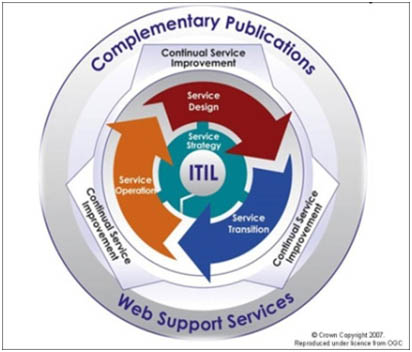Andy Trainer
14 Jan 2011
ITIL Training - Pre Course Reading

Silicon Beach Training run regular ITIL® Foundation Training Courses.
It is strongly encouraged that you spend the time to read and understand the pre-course reading as this will aid you significantly during the course.
We've put together an interactive ITIL Training Quiz, to help you test your knowledge further.
What is ITIL?
The Information Technology Infrastructure Library® (ITIL®) helps organisations improve the quality and reduce the costs of IT services that support their business objectives.
ITIL® is a registered trademark of AXELOS Limited, used under the permission of AXELOS Limited. All rights reserved.
ITIL History
ITIL originated in the 1980s when the British government determined that it was not receiving a sufficient level of IT service quality. First released as a series of 40 books in the late 1980s ITIL started to become recognised as the best practice framework for IT Service Management.
In the 1990s, the second version of ITIL was released and rapidly accepted by companies and government agencies in Europe and throughout the world. With ITIL V2, the number of books was reduced from the original 40 to 10. Of these, Service Delivery and Service Support were the two most widely adopted books.
In 2007, ITIL V3 was introduced. With ITIL V3, V2’s ten books were consolidated into five books, each approximately 300 pages in length and dedicated to a major activity—Service Strategy, Service Design, Service Transition, Service Operation, and Continual Service Improvement. Recent versions of ITIL since v3 have therefore been based around a Service Lifecycle.
One of ITIL’s primary benefits is that it provides a common vocabulary with a glossary of tightly defined and widely agreed upon terms, enabling all departments, agencies, customers, and service providers, to speak a common language. This is highly valuable, especially when establishing goals and in gaining a consensus regarding expected outcomes and business objectives.
Service Strategy
Service Strategy links IT service strategies to customer value. The identification of market opportunities for which services could be developed to meet a requirement on the part of internal or external customer ensures that every stage of the service lifecycle stays focused on the business case. The output is a strategy for the design, implementation, maintenance, and continual improvement of the service as an organisational capability and a strategic asset.
Key areas of this volume are:
- Service Portfolio Management - managing all services delivered
- Financial Management - managing costs
Key terms used within Service Strategy:
Utility: "Used to describe the functionality a service offers"
Warranty: "Used to describe the guarantee or service levels a service can offer"
IT Projects traditionally concentrated on solely functionality of an application or service but it is just as important to consider aspects such as availability, continuity (disaster recovery) etc as part of a service. Delivering an appropriate level of both will help to deliver value for the customer.
Service Design
Service Design involves the development of specifications that address all aspects of the proposed service, as well as the processes intended to support it, outlined in the service strategy.
Key areas of this volume are:
- Service Level Management
- Availability Management
- Capacity Management
- Continuity Management
- Security Management
Key terms used within Service Design:
Service Level Agreement: "A Service Level Agreement (SLA) is used to agree the levels of service required between the customer and the IT Service Provider"
Service Availability: "The end-to-end Availability agreed with a customer as part of an SLA"
Service Transition
Service Transition focuses on the implementation of the service design and the process of transitioning that service from “where we are” to “where we want to be.” New and enhanced services are subjected to production-quality assurance, including testing, change management, and release management, for controlled release into production. There is an area of overlap between Service Transition and Service Operation.
Key areas of this volume are:
- Change Management
- Release Management
- Service Asset and Configuration Management
- Knowledge Management.
Key terms used in Service Transition:
CMDB (configuration management data base):
“A database that contains details about the service providers assets and details of the important relationships between the assets.”
The CMDB is the major repository that many ITIL processes access. The information may be simple like the amount of RAM in a desktop, or it may be more complex such as storing the relationship between system changes and all the assets that change affects.
Service Operation
Service Operation focuses on the delivery and control process activities required to operate the services and maintain their functionality, as defined in service level agreements, and achieve a highly desirable, steady state of service management on a day-to-day basis.
Key areas of this volume are:
- Incident Management
- Problem Management
- Request Fulfilment
- Event Management
Key terms used in Service Operation:
An Incident: “Any event that is not part of the standard operation of a service and that causes, or may cause, an interruption to, or a reduction in, the quality of that service.”
An incident might be something that has been reported, such as a user reporting that he cannot access his corporate e-mail or a database server crash.
A Problem: “The unknown cause of one or more Incidents.”
Problems may sometimes be identified because of multiple incidents that exhibit common symptoms. Problems can also be identified from a single significant incident, indicative of a single error, for which the cause is unknown. Occasionally problems will be identified well before any related incidents occur.
Continual Service Improvement
CSI describes proven practices for continual improvement in the quality of the services that the IT organization delivers to the business.
Key areas of this volume are:
- Service Reporting
- Service Measurement
- The Deming cycle
- CSI Model
